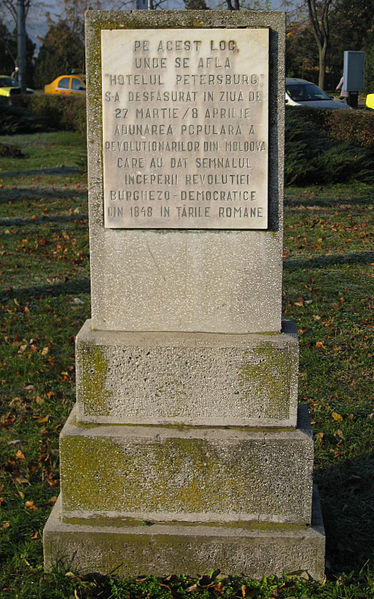Moldavian Revolution of 1848
The Moldavian Revolution of 1848 is the name used for the unsuccessful Romanian liberal and Romantic nationalist movement inspired by the Revolutions of 1848 in the principality of Moldavia. Initially seeking accommodation within the political framework defined by the Regulamentul Organic, it eventually rejected it as imposed by foreign powers and called for more thorough political reforms. Led by a group of young intellectuals, the movement was mostly limited to petitioning and constitutional projects, unlike the successful uprising taking place later that year in neighbouring Wallachia, and it was quickly suppressed. This was despite the fact that the Moldavian revolutionaries were more moderate and willing to compromise in their demands for reforms than their Wallachian counterparts, as Moldavian political and social life continued to be dominated by a landed, conservative aristocracy, with the middle class still embryonic.

Communist-era plaque marking the site of the Petersburg Hotel, where an assembly on 8 April met and drew up a petition for Prince Mihail Sturdza.
Romanians are a Romance-speaking ethnic group and nation native to Central, Eastern and Southeastern Europe. Sharing a common culture and ancestry, they speak the Romanian language and live primarily in Romania and Moldova. The 2021 Romanian census found that 89.3% of Romania's citizens identified themselves as ethnic Romanians.
Romanians in the Kingdom of Hungary, according to the 1890 census
Neacșu's letter to Johannes Benkner (former Transylvanian Saxon mayor of Kronstadt/Brașov) is the oldest document written in Romanian discovered to date.
Romanian revolutionaries of 1848 waving the tricolor flag
Romanians of Zakarpattia Oblast in Carpathian Ruthenia, western Ukraine, performing a traditional dance.





